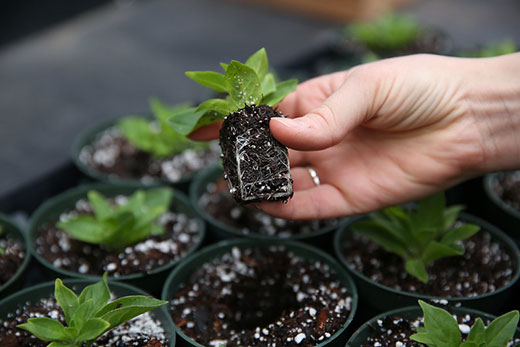
K-State horticulture expert Ward Upham says January marks an opportunity to get vegetables and flowers started indoors. | Download this photo
January provides opportunity to start vegetables, flowers indoors
K-State horticulture expert offers tips for buying, caring for seed
Jan. 7, 2021
MANHATTAN, Kan. – In case cabin fever has Kansas gardeners longing for warmer days, there’s good news: January marks an early opportunity to get some vegetables and flowers started.
“January is often a cold and dreary month for many gardeners,” said Ward Upham, a horticulture expert with K-State Research and Extension. “But planning for and starting vegetables and flower transplants from seed can make this a much more interesting time of year.”
Upham outlined the steps needed to purchase and plant seeds indoors in a recent issue of the Horticulture Newsletter, a weekly publication from Kansas State University that is available online and by email.
His recommendations include:
- Purchase recommended, quality seed. The varieties recommended for Kansas are available in a publication from K-State Research and Extension. “Also, talk to your neighbors, friends and your local garden center about what has worked well for them,” Upham said.
- Obtain your seeds from a reputable source. These may include garden centers and seed catalogs. “If choosing seeds from a business that does not specialize in plants, pay special attention to the package date to make sure the seed was packaged for the current year,” Upham said. “Though most seed remains viable for about three years, germination decreases as seed ages.”
- Determine the Date to Seed. You should know the target date for transplanting outside, and the number of weeks needed to grow the transplant indoors. The Jan. 5 K-State Horticulture Newsletter includes a table to help gardeners understand these timelines.
- Sowing seed. Do not use garden soil to germinate seed. It is too heavy and may contain disease organisms. Use a media made especially for seed germination.
Upham said additional tips include keeping seed moist, and growing the seeds in appropriate lighting and temperature conditions. A little TLC also helps, he said.
“Plants react to movement,” Upham said. “Brushing over the plants with your hand stimulates them to become more stocky and less leggy. Try 20 brushing strokes per day. However, brushing will not compensate for a lack of light or over-crowding.”
Move plants outdoors prior to transplanting so that they will become hardened to the sun and wind. “Start about two weeks before transplanting and gradually expose the plants to outside conditions,” Upham said. “Increase the number of hours and degree of exposure over a two-week period.”
For more tips, interested persons can send their garden- and yard-related questions to Upham at wupham@ksu.edu, or contact your local K-State Research and Extension office.

